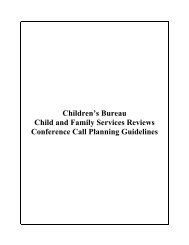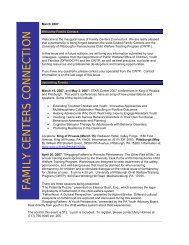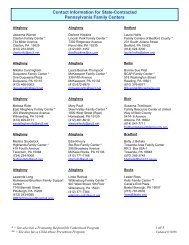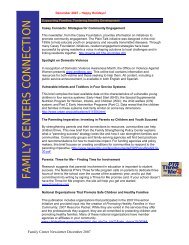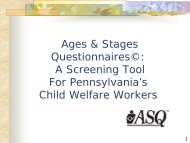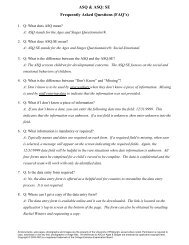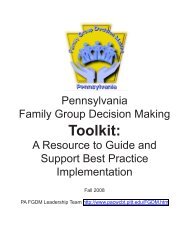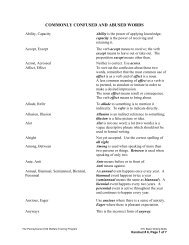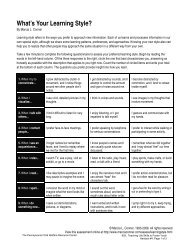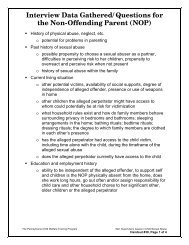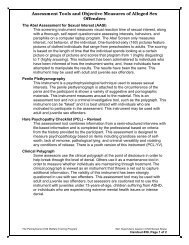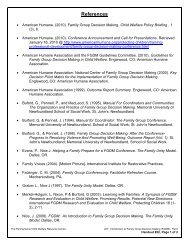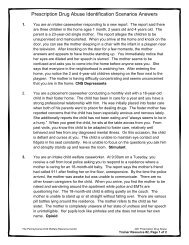Handout #20: The Blended Perspectives Meeting - Pennsylvania ...
Handout #20: The Blended Perspectives Meeting - Pennsylvania ...
Handout #20: The Blended Perspectives Meeting - Pennsylvania ...
You also want an ePaper? Increase the reach of your titles
YUMPU automatically turns print PDFs into web optimized ePapers that Google loves.
<strong>The</strong> <strong>Blended</strong> <strong>Perspectives</strong> <strong>Meeting</strong><br />
Goals of the <strong>Meeting</strong>:<br />
• Allow the family/kin to see how isolated the child/youth/caregiver is;<br />
• Identify strengths and needs of the child/youth/caregiver;<br />
• Identify the child/youth/caregiver’s Big Unmet Need; and,<br />
• Identify the individuals who will be active members of the child/youth’s Network<br />
for Life.<br />
It is important to note the <strong>Blended</strong> <strong>Perspectives</strong> <strong>Meeting</strong> (BPM) is not a place to make<br />
decisions. <strong>The</strong> purpose of the BPM is to accomplish the goals listed above. According<br />
to Kevin Campbell’s model, the decision making step and associated meeting is the<br />
environment in which the family makes final decisions.<br />
In attempting to meet the child/youth’s needs, it is important to remember that frequently<br />
the caregiver’s needs are not met. This directly affects the caregiver’s ability/inability to<br />
meet the needs of their child. This being the case, the points below, which offer what<br />
BPM preparation, facilitation, and follow-up could look like, might also be used to<br />
consider caregiver needs being unmet and how to support the caregiver so that he/she<br />
can then support the child/youth.<br />
<strong>Blended</strong> Perspective <strong>Meeting</strong> Considerations:<br />
• Prior to the <strong>Meeting</strong> (during the Engagement stage):<br />
o In conjunction with your supervisor and others on the family’s team,<br />
consider the following points:<br />
• Do you have identifying information and information concerning<br />
agency involvement:<br />
• Name of child,<br />
• Age,<br />
• Gender,<br />
• Ethnicity,<br />
• Years involved with Child Welfare and related agencies,<br />
• Number of placements.<br />
• Are you aware of the safety threats? Are you prepared to discuss<br />
them with the family? If so,:<br />
• What are they,<br />
• When did the threat(s) last happen,<br />
• When might it/they happen again.<br />
• Are you prepared to show how lonely the child/youth is in<br />
comparison to others outside the child welfare system in<br />
conjunction with the importance of building a Network for Life? Do<br />
you know:<br />
<strong>The</strong> <strong>Pennsylvania</strong> Child Welfare Training Program<br />
207: Family Finding<br />
<strong>Handout</strong> <strong>#20</strong>, Page 1 of 6
<strong>The</strong> <strong>Blended</strong> <strong>Perspectives</strong> <strong>Meeting</strong>, continued<br />
• How many connections the individual has in family, kin,<br />
community, etc.<br />
• What the nature of their relationship is with identified<br />
connections.<br />
• Are you fully aware of the urgency associated with this child/youth<br />
and his/her family’s situation and can explain it in a way that<br />
identified connections can understand? Do you know:<br />
• How soon planning decisions need to be made.<br />
• Whether a team has been developed or needs developed<br />
that consists of committed members.<br />
• If one has not been developed, how quickly the team needs<br />
to be developed to meet the planning decisions deadline.<br />
• With regard to placement-related cases, are you prepared to<br />
tell/discuss with the family:<br />
• Where the child/youth is now.<br />
• How long the child/youth likely be there.<br />
• Whether there may be more appropriate settings (kinshipbased)<br />
available.<br />
• <strong>The</strong> benefits of establishing/maintaining connections to help<br />
the child/youth in their existing placement setting.<br />
• With regard to siblings, are you prepared to discuss with the family<br />
and/or discover:<br />
• Whether or not any exist.<br />
• Who they are (name, age, gender).<br />
• Where they are (i.e., placement, home, etc.).<br />
• Whether the relationship between the identified child/youth<br />
and siblings is fostered. If not, why?<br />
• With regard to non-custodial caregiver(s):<br />
• Who are they?<br />
• Did you talk to them?<br />
• Are they involved?<br />
• Do they want to be involved?<br />
• What needs to be done to get them involved?<br />
• Do you know how many family/kin exist right now (ensuring that<br />
you fully review case records, perform Internet and other searches,<br />
engage all available sources, etc.)?<br />
• Regarding any existing child/youth and family team, do you know or<br />
have you considered:<br />
• Who is on the team and why?<br />
• Whether there should be more?<br />
<strong>The</strong> <strong>Pennsylvania</strong> Child Welfare Training Program<br />
207: Family Finding<br />
<strong>Handout</strong> <strong>#20</strong>, Page 2 of 6
<strong>The</strong> <strong>Blended</strong> <strong>Perspectives</strong> <strong>Meeting</strong>, continued<br />
• How many are family/kin?<br />
• How many are providers?<br />
• Whether or not they are all committed to serving as a<br />
member of the child/youth’s Network for Life.<br />
o Explain the meeting format and purpose of the meeting.<br />
• It is a preparation and planning meeting with the purpose being to<br />
get all the meeting participants on a similar page about the<br />
child/youth/family’s lack of and need for connections:<br />
• To learn from each other about each unique perspectives<br />
the participants have about the child/youth/family.<br />
• To understand what has and is happening in his/her life.<br />
• What is learned from the meeting will be used at a Family Group<br />
Decision Making meeting to make decisions about the future of the<br />
child/youth and/or family.<br />
o Discover functional strengths and needs. A service is not a need.<br />
o List the strengths and needs to be used at the <strong>Blended</strong> Perspective<br />
<strong>Meeting</strong>.<br />
o Identify three possible meeting dates.<br />
o Identify who is involved.<br />
• Twelve or more natural supports and family members.<br />
• Child or youth may attend; however, attendance is a safety decision<br />
which will need to be weighed in each situation. Keep in mind that<br />
safety issues take many forms. If the child/youth cannot attend,<br />
consider bringing a picture of child/youth.<br />
• Three to five service providers/agency staff (supervisor and/or<br />
caseworker).<br />
• <strong>Meeting</strong> facilitator.<br />
o Identify a meeting location and length of time.<br />
• Meet in a family friendly location – has to be safe.<br />
• No longer than two hours – aim for 90 minutes.<br />
• During the <strong>Meeting</strong>:<br />
o Perform welcome and introductions.<br />
• Introduce yourself by stating:<br />
• Ask individuals to introduce themselves, including:<br />
• <strong>The</strong>ir connection to the child/youth.<br />
• Why they are here.<br />
<strong>The</strong> <strong>Pennsylvania</strong> Child Welfare Training Program<br />
207: Family Finding<br />
<strong>Handout</strong> <strong>#20</strong>, Page 3 of 6
<strong>The</strong> <strong>Blended</strong> <strong>Perspectives</strong> <strong>Meeting</strong>, continued<br />
• What they most hope to result from this meeting.<br />
• Introduce the <strong>Blended</strong> Perspective <strong>Meeting</strong> by stating:<br />
“As the facilitator, my role is to make sure that we learn from<br />
each other our perspective about (Child/Youth’s Name). To<br />
do this, we’ll need to discuss what has and is happening in<br />
his/her life. We will use what we learn today to help inform<br />
decisions about (Child/Youth’s Name)’s future.”<br />
o Process out and write information about the child/youth and their<br />
caregiver(s):<br />
• <strong>The</strong> child/youth’s name (with correct spelling).<br />
• Age (In addition to when is his/her next birthday is).<br />
• Gender.<br />
• Ethnicity/cultural identity of youth. Identify any other ancestry than<br />
that of which the agency is aware.<br />
• # of years youth has had a social worker.<br />
• # of placement settings.<br />
• Living arrangement: including formal, informal, and private<br />
arrangements.<br />
• Educational: moves from setting to setting may involve<br />
educational issues.<br />
Note: <strong>The</strong> young person may or may not be made to change<br />
schools. This has the potential to greatly affect the young<br />
person. <strong>The</strong> family must be made aware of all the affects<br />
that the number of placement settings can have on a young<br />
person. A key point to consider is that each placement<br />
setting tends to equal 10 lost relationships.<br />
• Child/youth’s greatest strengths - each person identifies two.<br />
• Child/youth’s greatest needs - each person identifies one.<br />
• Connectograms: Use these to identify who is important to the<br />
child/youth. On the Connectogram, identify and capture the<br />
following:<br />
• <strong>The</strong> tiers of connectedness:<br />
o Kinship and family;<br />
o Friends;<br />
o Non-relative adult supports.<br />
• For those who say they will serve as supports, ask:<br />
o “Who is in child/youth’s life right now? Who sees<br />
him/her on a consistent basis?”<br />
<strong>The</strong> <strong>Pennsylvania</strong> Child Welfare Training Program<br />
207: Family Finding<br />
<strong>Handout</strong> <strong>#20</strong>, Page 4 of 6
<strong>The</strong> <strong>Blended</strong> <strong>Perspectives</strong> <strong>Meeting</strong>, continued<br />
o “Who loves this child?” Make connecting lines to<br />
show the flow.<br />
o “Who does the child love?” Make connecting lines to<br />
show the flow.<br />
o “If the youth moved or supports stopped getting paid<br />
(e.g., formal kinship care payments cease), who<br />
would stay involved?”<br />
• Now do a Connectogram for a comparable youth known to a<br />
relative who is not in placement. Keep in mind that this might<br />
not be a good idea if the child/youth is in the room (e.g., to<br />
see that a child/youth relative is better-liked/supported than<br />
the child/youth).<br />
• <strong>The</strong> goal of the Connectogram is to get everyone on the<br />
same page about the child/youth’s lack of and need for<br />
connections.<br />
• Identify, discuss, and come to consensus concerning the<br />
child/youth’s “big unmet need after discussing the connections (or<br />
lack thereof) as seen on the Connectogram(s). It may also prove<br />
useful to do a Connectogram on any existing caregivers, identify,<br />
discuss, and agree upon their “Big Unmet Need.”<br />
• Write the identified unmet need statement on flip chart paper. Ask<br />
the meeting members to provide the language for the statement.<br />
o Summarize and offer next steps:<br />
• Ask family members whether they need to meet again to make<br />
decisions about how to address the big unmet need(s). <strong>The</strong> hope is<br />
that they will acknowledge the fact that they need to meet again.<br />
• Offer Family Group Decision Making (FGDM) as an option. If the<br />
group likes the idea, work with the FGDM Coordinator to schedule<br />
a Family Group Decision Making meeting. If the group does not like<br />
the idea, offer the benefits of FGDM and/or explore other family<br />
engagement options.<br />
• Ask everyone to think about the role they can play in making the<br />
plans work.<br />
• Based on people’s ability to meet the needs of the<br />
child/youth/family, ask whether the team is complete. If not, ask<br />
who else needs to be involved.<br />
• After the <strong>Meeting</strong>:<br />
o Process out what occurred:<br />
• Review with your supervisor and other individuals on the family’s<br />
team what was learned during the <strong>Blended</strong> <strong>Perspectives</strong> <strong>Meeting</strong>.<br />
In considering whether the goals associated with the Planning step<br />
were achieved, again consider the goals offered at the beginning of<br />
<strong>The</strong> <strong>Pennsylvania</strong> Child Welfare Training Program<br />
207: Family Finding<br />
<strong>Handout</strong> <strong>#20</strong>, Page 5 of 6
<strong>The</strong> <strong>Blended</strong> <strong>Perspectives</strong> <strong>Meeting</strong>, continued<br />
this handout and think about whether the following points were<br />
addressed:<br />
• <strong>The</strong> possible isolation of the caregiver and the likely isolation<br />
of the child/youth (especially in placement cases);<br />
• Strengths and needs of the child/youth/caregiver;<br />
• <strong>The</strong> individual’s “Big Unmet Need;” and,<br />
o Did the individual and/or the family define the unmet<br />
need statement in a way that defines the individual’s<br />
wishes and needs?<br />
• Individuals who will be active members of the child/youth’s<br />
Network for Life were identified.<br />
Things to Consider Before, During, and After the <strong>Meeting</strong>:<br />
Lessons Learned:<br />
<strong>The</strong> <strong>Pennsylvania</strong> Child Welfare Training Program<br />
207: Family Finding<br />
<strong>Handout</strong> <strong>#20</strong>, Page 6 of 6



